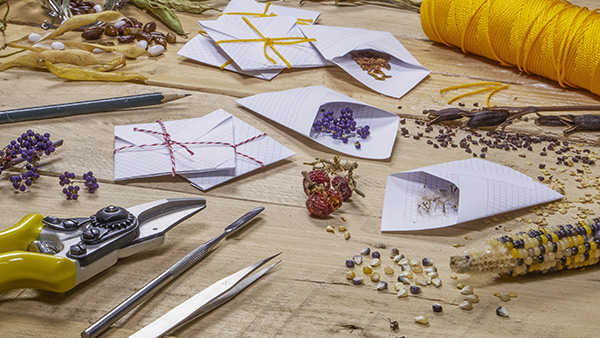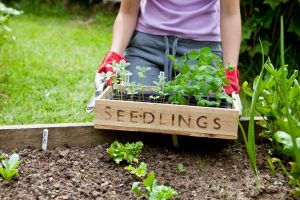
Advertisement
You can buy seeds at the local gardening supply store, so why do you need to learn how to harvest seeds?
Knowing how to properly harvest seeds is rewarding because this enables you to plant and harvest a sustainable food source throughout the year.
The benefits of harvesting seeds
On average, American families spend more than $13,000 annually on food per household. The figure represents a large percentage of the average family’s budget, but with inflation, economic instability and other factors, the cost continues to rise as years go by.
It can be difficult to serve meals made with fresh produce to your family regularly, especially if you live in a food desert — an area where there is limited access to affordable, healthy food.
While healthy eating shouldn’t be a luxury, it is often a struggle for those on a tight budget. Growing and maintaining a flourishing garden is important if you want to live sustainably and independently. Gardening can also help you save money on groceries.
Harvesting seeds and growing your own fruits and vegetables will let you avoid produce that contains traces of harmful chemicals like pesticides. And while you have the option to buy organic food, they are more expensive than non-organic options. They are also not available in many rural locations.
Tips for properly harvesting seeds
If you’re a beginner, follow the steps below to harvest seeds for your home garden:
- You will need the following gardening tools: shovel, pruning shears, scissors, containers, envelopes and a pen for labeling and making notes.
- Let the plant fully mature before you harvest the seeds.
- Remove the seeds, seed pods or bulbs and store them in an envelope or jar.
- Separate the seeds from surrounding pods or plant matter.
- Store the seeds in paper envelopes or bags to protect them from moisture and humidity.
- Store your seed collection in a cool, dark, dry and ventilated room.
- Check your planting calendar before planting your harvested seeds.
The process of harvesting seeds can be broken down into five phases: gathering, cleaning, drying, storing and planting seeds. Note that seed harvesting time varies depending on the fruit or vegetable in your garden.
Always check your planting calendar and plan your gardening regimen accordingly. This is important because some fruits and vegetables produce seeds biennially and others are annual or perennial.
To save your time and effort, be selective about the seeds that you preserve since not every crop is going to be a good one.

Sustainable gardening: what to grow
Before you can harvest seeds, you must first have a home garden.
When deciding what to plant in your garden, choose fruits, vegetables, herbs and edible flowers that will provide you with the vitamins and minerals you need for a balanced diet.
Here are some of the best crops to plant in your garden and for seed harvesting:
- Beans
- Beets
- Broccoli
- Carrots
- Corn
- Cucumbers
- Lettuce
- Melon
- Peas
- Peppers
- Potatoes
- Radish
- Squash
- Tomatoes
When learning about seed harvesting, it’s best to read up on the basics of the biology of pollination, seeding and the life cycle of a plant. This will help you learn how to correctly gather seeds at the ideal time and plant the seeds at the best time of the year.
Take note of when you plant your crops and when you gathered the seeds to organize your seed collection.
If you are a gardening beginner, note that that there are self-pollinating crops that are easy to grow and harvest seeds from, like beans, lettuce, peas and tomatoes.
Here’s a guide to the difference between hybrid species and those that spread through open pollination.
Open-pollinated seeds
Open pollination is a form of natural plant reproduction that occurs in one of two ways:
- In open-pollination, cross-pollination occurs when two varieties of the same plant species reproduce with the help of natural pollinators like birds or the wind. This is common with squash plants when you have different varieties planted close together.
- Self-pollination occurs when a plant has both male and female parts so it can reproduce by itself. Self-pollinating plants like tomatoes breed true to the parent plant and you don’t need to isolate them to avoid contamination from other varieties.
Hybrid seeds
Hybrid seeds develop after the highly controlled cross-pollination between different varieties of the same species of plants. Although cross-pollination occurs naturally, the results are too random to be reproduced and marketed on a large scale.
This means the hybrids you see in stores are not open-pollinated like heirloom varieties but created under controlled conditions.
Heirloom seeds
“Heirloom” refers to older, well-established varieties of open-pollinated plants and seeds that have developed stable genetic characteristics.
Before, heirloom seeds were considered rare seeds. Now, you can look for and use heirloom seeds to maintain variety in your home garden.

Tips to enjoy a sustainable, year-round harvest, regardless of climate
Even if you don’t live in an area with temperate climates, you can successfully grow foods year-round.
And while growing crops in colder areas can be difficult, it’s not impossible. With some extra work, you can grow cold-hardy crops.
When gardening in colder climates, keep in mind that biennials require two full growing seasons before seeds are produced.
If you live in a warmer area, biennials planted in the fall will produce seeds the following spring, like beets, cabbages and carrots.
Time your planting and harvesting, especially when plants grow at different rates.
Aside from sowing seeds, you can improve your garden by planting lots of different root vegetables. Doing this helps add variety, flavor and nutrition to your annual harvest.
Take notes to keep track of your plant-growing schedule. Monitoring your plants makes it easier to determine when to harvest crops and seeds.
Proper storage is crucial when you harvest your own seeds. Store harvested seeds in a dark and dry, well-ventilated area. If your seeds are improperly stored, they may become unusable.
Exposure to humidity and moisture will allow mildew to grow on your seeds and you can’t plant contaminated seeds in your garden. Making sure you have a steady supply of healthy seeds means you can enjoy a bounty harvest in a healthy, sustainable garden.
Become more self-reliant by growing fresh produce in your home garden. Harvest seeds from healthy crops so you have a steady supply of fresh, nutritious and organic fruits and veggies year -round.
When harvesting seeds from your successful crops, store them properly and plant them strategically. For best results, use a planting calendar, take detailed notes and learn about basic plant biology.
Like many endeavors, learning how to harvest seeds takes some time and effort. By putting in the work, you can plant and establish a bountiful garden that will provide your family with fresh produce.
Sources:
Advertisements







